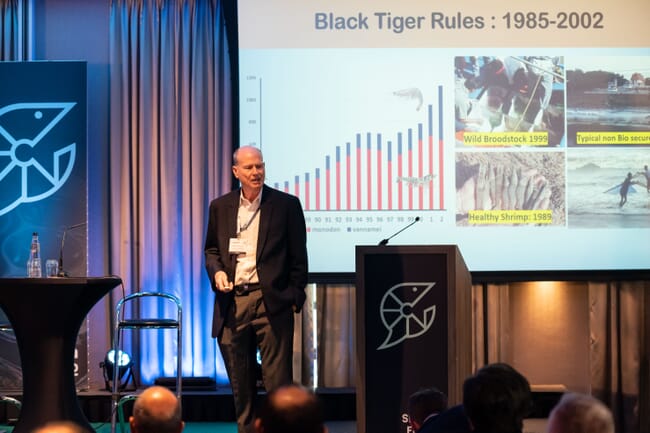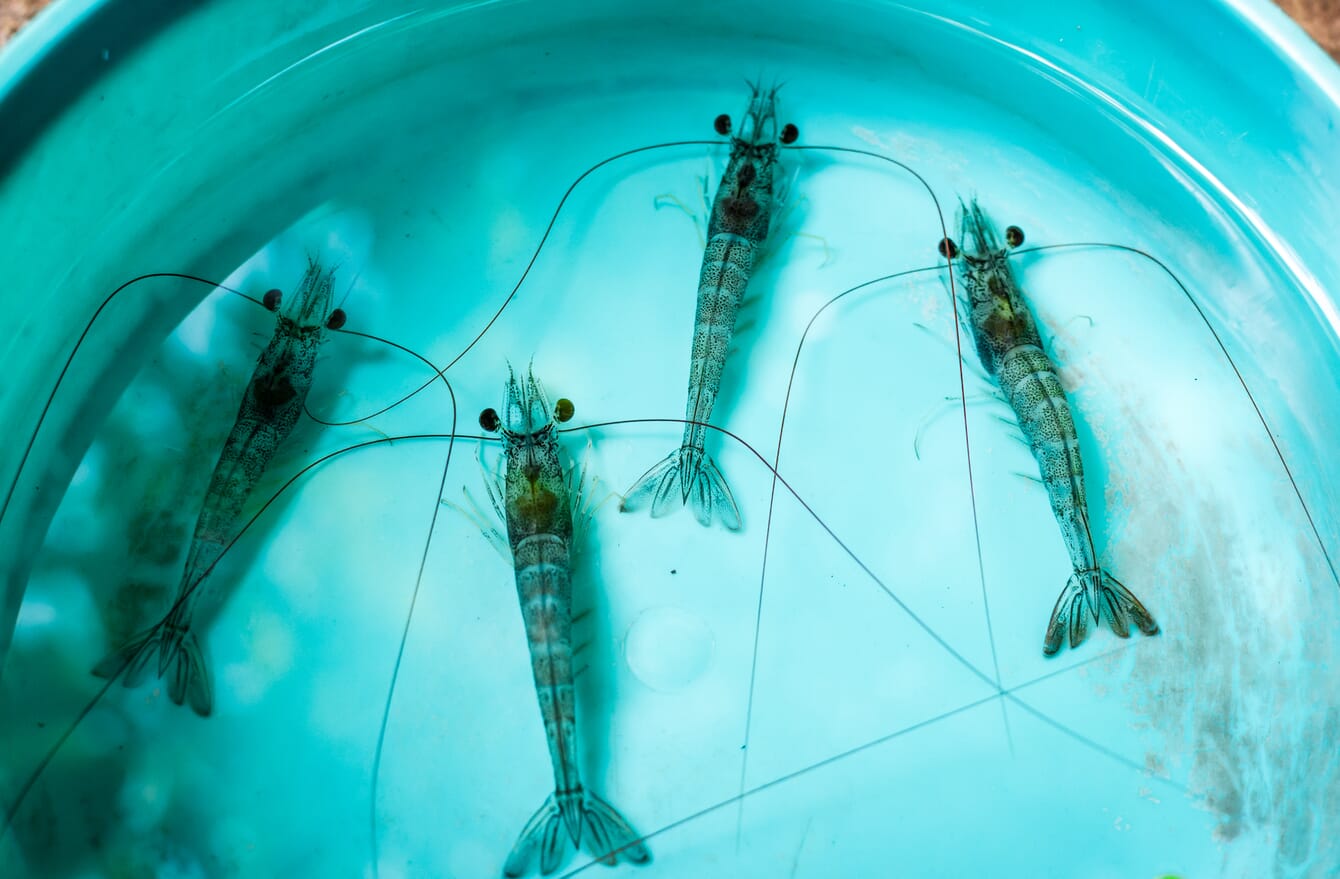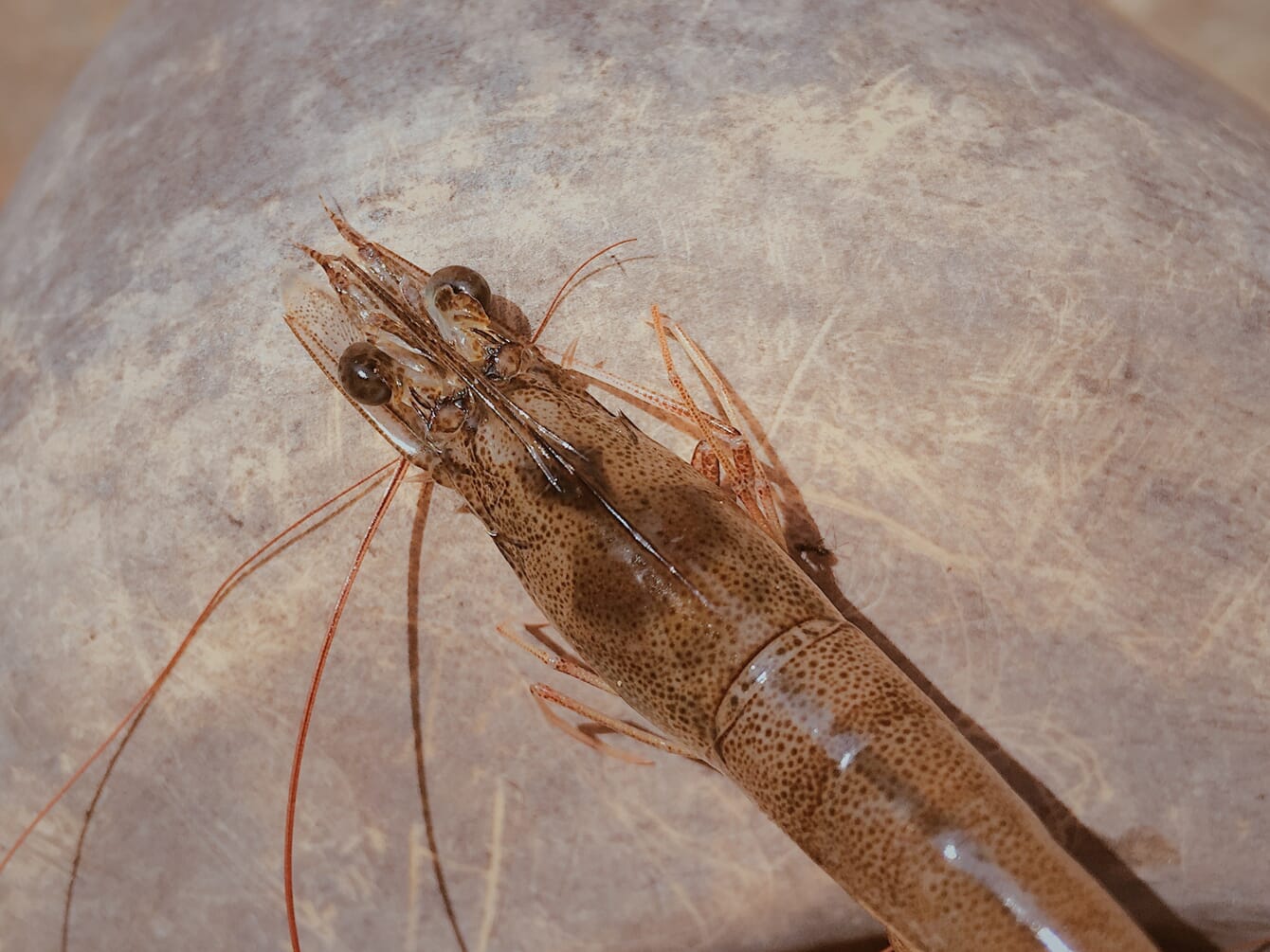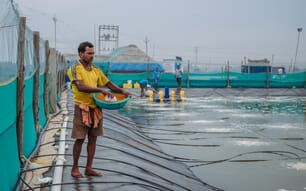
Macintosh, who is executive vice-president of Charoen Pokphand Foods (CPF) and CEO of Homegrown Shrimp, has played a key role in developing several lines of shrimp over the course of an illustrious career. And he argues that – in a well-managed farm – fast growing shrimp lines are hard to beat.
Indeed, he reflects that Homegrown’s latest line, known as the Bolt line, has improved one RAS producer’s farming performance dramatically – from taking 120 days to grow the shrimp to 24 g, to 82 days to grow them to 34 g, without any reduction in survival rates.
Scepticism in the shrimp sector
However, despite the emergence of farmers who can demonstrate that fast growing shrimp can be extremely successful, Macintosh reflects that there is a growing scepticism about such lines, in particular relating to their ability to withstand disease challenges.
“The first doubts happened during the initial outbreaks of EMS [early mortality syndrome] – in 2010, 2011 and 2012, when the CP shrimp got the name of ‘fast grow, fast die’,” recalls Macintosh, who was selling a CP fast-growing strain in Asia at the time.
“But when we evaluated the data it showed that the other lines were dying at the same rate too. In Hainan island, in China, we had a 75 percent market share, so the majority of the animals that died were ours. Not being a proud individual I sent the sales team out to go find some of these ‘no die shrimp’ so I could clean them up and breed them. But when they returned they told they didn’t exist – maybe some live another two days, but it’s not enough to be worth [developing a breeding programme for],” he continues.
“When we looked at the South American stocks, which were said to be tolerant of EMS, but when they got smuggled into Asia they died like all the others,” he adds.

Fast and robust?
CP did, however, succeed in breeding EMS tolerance into a line of shrimp – with survival rates in challenge tests increasing from 30 to 90 percent.
“At that point we didn’t have acute mortality from EMS and we didn’t have EHP, so there was a period of grace, when fast-growth animals had a good reputation again. Post-EMS there was a huge growth jump at the farm level,” he recalls.
However, while some salesmen might have attempted to take sole credit for the sector’s upturn in fortunes, Macintosh explains that the improvements in shrimp genetics were accompanied by improvements in farming practices and so the upturn in growth rates shouldn’t all be attributed to the success of CP’s breeding programme.
These husbandry improvements included the introduction of shrimp toilets, which helped to keep pond bottoms clean and reduced the concentration of aphns toxins in the ponds.
“EMS is not an infection as we know them, it’s a toxicosis centred on the environment, which grows on high nitrogen waste – whether it be dead shrimp, shrimp shells, old feed or dead phytoplankton – which grows the aphns bacteria that produce the toxin levels required to kill a shrimp. It was the management of the environment that was crucial. Taking care of the organic waste didn’t just reduce the toxin levels, it also removed the other bad conditions, leading to increased straight line growth for the duration of a culture cycle,” Macintosh reflects.
“Pre-EMS, in 2010, the average harvest size was 16-18 g. But by 2019-2020 the average harvest size was up to 28 g, with high percentages above 30 g. You would have had none of that without EMS leading to breeding improvements in robustness and tolerance to vibrio toxins. But, while genetics was important, pond management was equally important,” he adds.
The lesson learned, according to Macintosh, is clear.
“As genetics change the animals, so management must change with the genetics – if you maintain the same management, you may not see improvements in genetics and that’s exactly what happened to our programme at CP,” he explains.
“From 2004 to 2006 we were improving the animals’ growth rates in our lab, but the farmers were seeing no better growth and were complaining that average weekly growth rates were only 1.2 g, not 1.6 g like we were claiming,” he elaborates.
Management changes
Being practically-minded, and convinced that the farmers were missing a trick, Macintosh was directed to manage a small R&D shrimp farm for CP to see whether he could replicate the success of their lab trials in the field. It was demonstrated that farmers had not made the necessary changes in pond and feed management to allow the new strains of shrimp to fulfil their growth potential.
“If you use the old growth curve and feed for 1.2 g a week, you’re going to get growth rates of 1.2 g a week – that’s what the feed rate will support,” he observes.
However, by increasing the feed rates and managing the water quality, Macintosh was quickly able to confirm that pond farm growth rates could be increased in proportion to the increased growth rates achieved in the genetic development centre. CP technical teams could then educate the farmers to the management required to take advantage of the faster growing genetic strains and in a short period of time there was widespread adoption of the newer management concept to provide the benefit of the fast-growing strains.

Another factor that needed to be adjusted – Macintosh soon realised – was the oxygen level. Oxygen level guidelines needed to be increased with the increased feed and growth rates.
The initial shrimp stocks had an oxygen guideline of 4.8 ppm which maximised growth and survival, but by 2010 the oxygen level had increased to 5.3 or 5.4 ppm and – today – I’d peg it at 5.6 or 5.8 to keep the shrimp healthy when they’re metabolising and growing as fast as they are,” he explains.
He also soon realised the need to change the composition of the shrimp feeds.
At the turn of the millennium, when monodon still dominated Asian shrimp production, CP’s monodon feed had a protein level of 38-42 percent, recalls Macintosh, and farmers in Asia wanted to use similar protein levels when they began to switch to vannamei production.
While Macintosh initially argued that protein levels for vannamei could be should be significantly lower – both as these early vannamei grew slower than the monodon and because an unnecessarily high protein diets can effectively poison ponds by increasing nitrogen levels in the water – he found it was difficult to persuade the farmers to follow suit.
“When I was introduced to vannamei farming in Central America in the early 1990s – protein levels in ‘high quality’ feeds were sometimes as high as 42 percent. But, given the growth rate potential of the shrimp at that time; this level was too high,” he recalls.
Macintosh, persuaded some farmers to try a lower protein diet , first 38 percent, and then 36 percent.
“Every time I pushed back there was an increase in survival and productivity, but no decrease in growth rates. You want to use as low a protein percentage to satisfy the animal you’re growing as possible – because the better the environment, the better the growth,” he explains.
Over time he was able to reduce the protein content in the diets used on his farm to 28 percent but, once the faster growing shrimp were available, we started to raise the protein level in the diet, once again feeds contained 36 percent protein, supporting up to an average growth rates of 3.5 g a week.
“And If you want to achieve growth rates of 6-7 g a week, you need to get closer to 42-45 percent protein. It really depends on what growth rate you think you can get out of the animal and the environment ,” he explains.
“It’s the growth rate potential and environment, not the species that should dictate the protein level of the feed. With faster potential growth rates, more and more vannamei farmers are now using ‘monodon feeds’,” he adds.
A cautionary tale
Despite the improved growth rates seen by some farmers who combined high protein feeds with fast growing shrimp lines, the rise in pond failures, particularly in Asia, led to a growth in demand for shrimp that were more robust, rather than those purely selected to be fast growing. But Macintosh argues that these failures are more related to pond mismanagement then to any inherent weakness in the shrimp. And that the farmers’ issues with growing mortalities were largely based on them failing to adapt their feeding strategies and feeds to the animal and the environment– notably their dogmatic approach to high protein diets fed at higher and higher rates for the increased growth rates.
“High protein does not guarantee fast growth. It’s only required to get the phenotypic fast growth from fast growth strains if the conditions are good and the genetics support it. But if your shrimp are genetically selected for fast growth, then high protein may equate to worsening pond conditions, thereby reducing survival and productivity. If a farm is only getting growth rates of 2 g a week they are hurting themselves by feeding diets with 42 percent protein,” he advises.
As a result, he thinks that pond mis-management created the demand for more robust shrimp, and suggests that the switch from fast growth to more lines labelled as robust might be unnecessary. If only the farmer properly manages feed rates, protein levels, and pond conditions. Do not exceed pond, farm, or general area environmental carrying capacities.
“Don’t use genetics to solve your problems. Genetics are a tool to improve your efficiency, but genetics should never be seen as a solution to a problem. That is one of the big misconceptions farmers make. In reality you have to apply the biosecurity and appropriate density and management of the pond for your shrimp genetics to optimise your production,” he elaborates.

However, increasing protein levels can make sense for fast growing vannamei strains in the right circumstances, according to Macintosh




